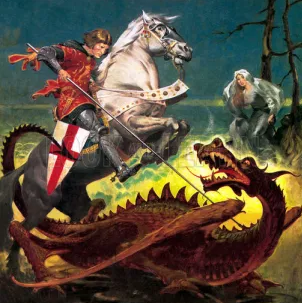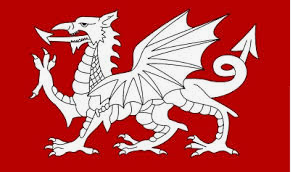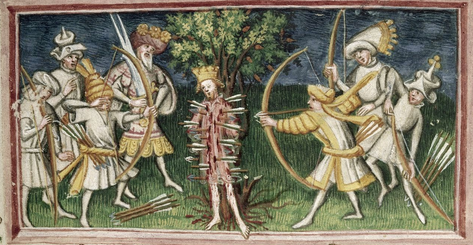Patron Saints and flag shagging. This is 2025 .... and you don't even have the right Saint

Saint George has nothing whatsoever to do with England. There is no connection, so why are we still waving his bloody Flag? The 23rd of April? Time for gammon, pub bores, and Britain First keyboard warriors to deck themselves in the red cross of St George, presumably between their 'forriners go home' and 'save are cuntry' rants and dog-whistle retweets of the TwatFox. But the delicious irony is Saint George was about as English as a döner kebab. Probably born in Cappadocia (modern-day Turkey), George never stepped foot in the land of roast beef and rain. And yet somehow, he became the poster boy of English nationalism. How did this happen? And more importantly, why do we even need a patron saint in the 21st century?
If we were truly patriotic as a nation our Saints Day would be 20th November.
Saint George: Myth, Martyrdom, and Military PR
Saint George was a Roman soldier, born around 280 AD, likely of Greek and possibly Palestinian ancestry. He served under Emperor Diocletian, who later had him executed for refusing to renounce Christianity during a purge of Christians in the army (Walter, 2003). His martyrdom got him sainted, as was the custom for early Christian heroes. The whole “dragon-slaying” thing? That was added centuries later during the 11th century Crusades, pure mythologised claptrap lifted from earlier legends and pagan folklore (Phillips, 2010).George was dragged into the English consciousness thanks to foreign wars, ironic, isn't it? Richard the Lionheart adopted George as a spiritual mascot during the Third Crusade. In 1348, Edward III made him the patron of the Order of the Garter: a chivalric knighthood dripping in feudal elitism and monarchy-sycophancy (Mortimer, 2006). And from there, George became the go-to symbol for English militarism, the monarchy, and over time a completely fabricated sense of English identity.
And then there's the flag: the flag of Saint George was never exclusively English until quite late in the game. It was part of a shared medieval Christian military culture, and many regions, cities, and nations used it before or alongside the English.
Genoa, a powerful maritime republic in what is now northern Italy, used the red cross on white from as early as the 12th century — before England did. It was their state flag and naval ensign.
- English ships sailing in the Mediterranean would sometimes fly the Genoese flag to benefit from Genoa’s naval protection, especially against pirates.
- There’s even a legend (though disputed) that England paid Genoa for the right to use the St George flag for its navy. Some versions say this arrangement happened under Richard the Lionheart or Edward I, though there's no solid documentary proof.
The red cross on white was a common Crusader symbol — not a national identifier, but a sign of fighting for Christendom. It was worn by soldiers from:
- The Holy Roman Empire
- The Papal States
- Various French duchies before they standardized on other symbols (e.g., blue and gold fleur-de-lis)
- Knights Templar sometimes used a red cross, though theirs was usually on white mantles with variations (and a more stylised cross).
It’s not unique to one saint, either, cross insignia were fluid: different colours and designs signified different national or religious orders.
In medieval Spain, parts of the Crown of Aragon, especially the city of Barcelona, also used a red cross on white. St George was hugely popular there too, and is still Catalonia’s patron saint (celebrated on La Diada de Sant Jordi, 23 April, same as England). Barcelona’s coat of arms includes the red cross of St George, not as a national flag, but as a nod to Christian military victory and protection.
The modern flag of Georgia (Eastern Europe) is a red-on-white design with five crosses, clearly inspired by the St George motif. George is the nation’s patron saint, and while their current flag was adopted in 2004, it revives medieval Georgian heraldry linked to George, who has deep historical roots in the Eastern Orthodox tradition.
The Republic of Ragusa: This small but wealthy medieval maritime republic (in what is now Croatia) also used a white flag with a red cross. Another example of a port city with a strong Christian and trading identity embracing the symbol.

St George: He was imposed on England by the French, he didn't kill a dragon and as a Roman he probably didn't have hair like Emo Phillips
So this symbol of supposed Englishness brought to England by the Angevins and as such is deeply French and the Kings who adopted it didn't even speak English.
The earliest English use of the red cross on white is often linked to Richard I, who was born and raised in Anjou, spoke French as his first language, and spent most of his life campaigning in France and the Holy Land.
- Crusader Symbolism: The red cross on white was commonly used by French crusaders, including those from Anjou, Normandy, and Aquitaine. Richard I, as a leading commander in the Third Crusade, adopted this cross while fighting under the Christian banner. It wasn’t yet 'St George’s Cross' it was simply a crusader cross.
- French Heraldic Influence: The red-on-white colour scheme was popular among French knightly orders and municipal militias in the 12th century, particularly in regions like Anjou and Poitou. So it’s highly likely that the design of the flag has Frankish origins, not English.
- Richard's Legacy: Although he ruled as King of England, Richard considered himself more French than English. He spent only about six months of his reign in England. Yet his military prestige, especially at the Siege of Acre and Battle of Arsuf, helped elevate the red cross as a symbol of knightly heroism. After his death, this symbolism was retroactively attached to St George.
- Angevin Identity = Chivalric Christianity: The House of Anjou promoted a blend of courtly culture, religious zealotry, and martial glory, and the red cross fit that branding perfectly. When English kings like Edward III later embraced this symbolism, they were borrowing from an Angevinesque image of the pious warrior king.
Saint Edmund: An Actual Anglo-Saxon Saint
Before the foreign Roman soldier muscled in, England’s original patron saint was Edmund the Martyr, King of East Anglia. Born around 841 AD, Edmund died resisting a Viking invasion, refusing to renounce his Christianity and being tied to a tree and shot full of arrows in 869 AD.

Edmund, King of East Anglia, died during a Viking invasion led by the legendary Ivar the Boneless and his brother Ubba, key figures in the so-called Great Heathen Army that ravaged Anglo-Saxon England. The Anglo-Saxon Chronicle, a key source of early English history, records that the Vikings "rode across Mercia into East Anglia, and took up winter quarters at Thetford," and that “King Edmund fought against them, and the Danes won the victory, killed the king and conquered the land” (ASC, entry for 869, Manuscript A).This account is brief and factual, but later hagiographies, particularly the “Passio Sancti Eadmundi”, written by Abbo of Fleury around 985 AD and translated by Ælfric of Eynsham around 1000, are dripping in dramatic martyrdom and miracle. According to Abbo, Edmund was captured, refused to renounce his Christian faith or submit to the pagan invaders, and was brutally executed as a result.
"They tied him to a tree and scourged him with whips. Then, when he was bloody and broken, they shot arrows at him ‘as if to make him a hedgehog,’ before finally beheading him with an axe." (Abbo of Fleury, Passio Sancti Eadmundi, ca. 985 AD)
The image of Edmund being filled with arrows like Saint Sebastian became iconic in medieval iconography — one reason for the power and spread of his cult.
Like all good saints, Edmund didn’t just die, he got better. A few greatest hits from his miracle catalogue:
- The talking head: According to legend, after the Vikings tossed his severed head into the forest, Edmund’s followers were led to it by a talking wolf that guarded it and cried out “Here, here, here!” (Abbo of Fleury, c. 985). Not kidding, people really believed this shit.
- Incorruptibility: When his remains were later exhumed (by which time he was already being venerated as a saint), they were supposedly found to be incorrupt — his body miraculously preserved despite the mutilation and passage of time. Classic sign of sanctity in the medieval Church.
- Healing miracles: His shrine at Bury St Edmunds became a centre of pilgrimage and was credited with healing the sick and curing disease. There were even claims his presence repelled Danish raids (which is rich, considering the Danes killed him in the first place).

King Edmund was flayed alive, peppered with arrows and then decapitated. His Killer, Ivor the Boneless wasn't fucking about
Why Edmund Mattered (Until He Didn’t)
Edmund was massively popular in pre-Conquest England. King Canute, a Danish Christian king, even promoted his cult and declared him patron of England around 1016, a politically shrewd move to unify Anglo-Danes under one sacred figure. His shrine at Bury became one of the richest and most visited in England, up there with Thomas Becket’s at Canterbury in terms of importance.But after the Norman Conquest, foreign rulers preferred foreign saints. George, with his knightly, pan-European appeal and Crusader credentials, slowly eclipsed the homegrown martyr. By the 14th century, George had fully usurped Edmund, thanks to royal endorsement from Edward III and the Order of the Garter.
Edmund ruled here, fought here, and died here. His remains were buried at Bury St Edmunds, a town literally named after him (Ridyard, 1988). Unlike George, Edmund was English to his bones. Well, actually he wasn't as England didn't exist at this time. It wasn't until 60 years later under the Æthelstan, the grandson of Alfred the Great and the son of Edward the Elder that the Kingdoms of England were merged into a single entity. And crucially, the cult around him was grassroots, built on local devotion, not imposed top-down from courtly elites.So why did the establishment ditch him? Simple: Edmund was too small-time for the grandiose propaganda needs of a Plantagenet monarchy obsessed with imperial pretension and European warfare. George, the militant Roman with an impressive European fan club, fit the medieval marketing brief for power, prestige, and Church authority. The monarchy wanted a saint who looked good on a horse and sounded good on a battlefield. The English people? They weren’t consulted, of course.

Why Do We Need a Patron Saint at All?
Let’s get to the real question: what kind of insecure, flag-shagging basket case of a nation still clings to medieval mascots in the age of climate collapse, crumbling public services, and endless right-wing psychodramas? Patron saints are relics of theocracy, the days when Church and State were one, and identity was imposed by crown and cross. Saints were used to justify wars, sanctify rule, and divide populations. Today, clinging to St George, or any saint for that matter, isn't tradition: it's sentimental reactionary cosplay. We don’t need a saint to tell us who we are. We need investment, equality, and a national identity that isn’t built on bloodshed, Empire, or fairy tales of dragon-slaying Roman soldiers. A healthy country doesn’t need to sanctify its nationalism. It builds solidarity from lived reality not medieval fantasy.
Ditch the Dragon-Killer, own your shit
The St George’s Cross has been hijacked by racists, misused by governments, and weaponised by charlatans in on GBeebies. But the real insult is deeper: the English ruling class handed us a myth and told us to wave it like it meant something. They airbrushed out the homegrown saint, a native king who actually resisted foreign invasion in favour of a distant, elite-friendly PR stunt. If you're going to worship a patron saint, at least pick one who walked the same mud, breathed the same air, and didn’t get canonised for marketing purposes. But better still? Stop worshipping saints altogether. Maybe then, we can build an England that isn't built on delusion, dogma, or dragons.
This of course ignores that Church of England cannon states that Saints Days cannot fall on Easter Week so this year it's on 28th April not 23rd.
And lets face it, the dragon banner of St Edmund is far cooler than a fucking cross.
References:
- Walter, C. (2003). The Warrior Saints in Byzantine Art and Tradition. Ashgate Publishing.
- Phillips, J. (2010). Holy Warriors: A Modern History of the Crusades. Vintage.
- Mortimer, I. (2006). The Time Traveller's Guide to Medieval England. The Bodley Head.
- Ridyard, S. J. (1988). The Royal Saints of Anglo-Saxon England: A Study of West Saxon and East Anglian Cults. Cambridge University Press.
- The Anglo-Saxon Chronicle, translated by Michael Swanton, Routledge, 1996.
- Abbo of Fleury, Passio Sancti Eadmundi (c. 985 AD), translated by Ælfric of Eynsham, in Ælfric’s Lives of Saints, ed. and trans. Skeat, EETS, 1881–1900.
- Ridyard, Susan J. The Royal Saints of Anglo-Saxon England, Cambridge University Press, 1988.
- Chaney, William A. The Cult of Kingship in Anglo-Saxon England, University of California Press, 1970.
- Licence, Tom. Edward the Confessor: Last of the Royal Blood, Yale University Press, 2020.

